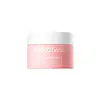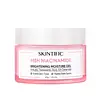What's inside
What's inside
 Key Ingredients
Key Ingredients

 Benefits
Benefits

 Concerns
Concerns

No concerns
 Ingredients Side-by-side
Ingredients Side-by-side

Water
Skin ConditioningKaolin
AbrasiveGlycerin
HumectantCetearyl Alcohol
EmollientDipropylene Glycol
HumectantOryza Sativa Bran Oil
EmollientEthylhexyl Palmitate
EmollientCI 77891
Cosmetic ColorantPolysorbate 60
EmulsifyingDimethicone
EmollientLactobacillus/Punica Granatum Fruit Ferment Extract
Skin ConditioningNiacinamide
SmoothingMagnesium Aluminum Silicate
AbsorbentPEG-100 Stearate
Glyceryl Stearate
Emollient1,2-Hexanediol
Skin ConditioningHydroxyacetophenone
AntioxidantXanthan Gum
EmulsifyingPEG-20 Stearate
EmulsifyingHydroxyethyl Acrylate/Sodium Acryloyldimethyl Taurate Copolymer
Emulsion StabilisingChlorphenesin
AntimicrobialBisabolol
MaskingButylene Glycol
HumectantAllantoin
Skin ConditioningPolyisobutene
Pentaerythrityl Tetra-Di-T-Butyl Hydroxyhydrocinnamate
AntioxidantEthylhexylglycerin
Skin ConditioningDisodium EDTA
CI 77491
Cosmetic ColorantGentiana Scabra Root Extract
Skin ConditioningPEG-7 Trimethylolpropane Coconut Ether
EmulsifyingAroma
Polysorbate 80
EmulsifyingPropylene Glycol
HumectantSorbitan Isostearate
EmulsifyingPentylene Glycol
Skin ConditioningLactobacillus/Soymilk Ferment Filtrate
Skin ConditioningCaprylyl Glycol
EmollientPhenoxyethanol
PreservativeSodium Hyaluronate
HumectantMaltodextrin
AbsorbentSalicylic Acid
MaskingAcacia Senegal Gum
MaskingArtemisia Vulgaris Extract
Skin ConditioningTocopherol
AntioxidantCentella Asiatica Leaf Extract
Skin ConditioningAlchemilla Vulgaris Extract
AstringentTrehalose
HumectantPanicum Miliaceum Seed Extract
Skin ConditioningSophora Flavescens Root Extract
AntioxidantOpuntia Ficus-Indica Stem Extract
Skin ConditioningOphiopogon Japonicus Root Extract
Skin ConditioningHibiscus Abelmoschus Seed Extract
MaskingPyrus Cydonia Seed Extract
MaskingSecale Cereale Seed Extract
AbrasiveGlycine Soja Seed Extract
Skin ConditioningLactobacillus Ferment
Skin ConditioningLeuconostoc/Radish Root Ferment Filtrate
AntimicrobialCastanea Sativa Seed Extract
Skin ConditioningHelianthus Annuus Seed Extract
Skin ConditioningWater, Kaolin, Glycerin, Cetearyl Alcohol, Dipropylene Glycol, Oryza Sativa Bran Oil, Ethylhexyl Palmitate, CI 77891, Polysorbate 60, Dimethicone, Lactobacillus/Punica Granatum Fruit Ferment Extract, Niacinamide, Magnesium Aluminum Silicate, PEG-100 Stearate, Glyceryl Stearate, 1,2-Hexanediol, Hydroxyacetophenone, Xanthan Gum, PEG-20 Stearate, Hydroxyethyl Acrylate/Sodium Acryloyldimethyl Taurate Copolymer, Chlorphenesin, Bisabolol, Butylene Glycol, Allantoin, Polyisobutene, Pentaerythrityl Tetra-Di-T-Butyl Hydroxyhydrocinnamate, Ethylhexylglycerin, Disodium EDTA, CI 77491, Gentiana Scabra Root Extract, PEG-7 Trimethylolpropane Coconut Ether, Aroma, Polysorbate 80, Propylene Glycol, Sorbitan Isostearate, Pentylene Glycol, Lactobacillus/Soymilk Ferment Filtrate, Caprylyl Glycol, Phenoxyethanol, Sodium Hyaluronate, Maltodextrin, Salicylic Acid, Acacia Senegal Gum, Artemisia Vulgaris Extract, Tocopherol, Centella Asiatica Leaf Extract, Alchemilla Vulgaris Extract, Trehalose, Panicum Miliaceum Seed Extract, Sophora Flavescens Root Extract, Opuntia Ficus-Indica Stem Extract, Ophiopogon Japonicus Root Extract, Hibiscus Abelmoschus Seed Extract, Pyrus Cydonia Seed Extract, Secale Cereale Seed Extract, Glycine Soja Seed Extract, Lactobacillus Ferment, Leuconostoc/Radish Root Ferment Filtrate, Castanea Sativa Seed Extract, Helianthus Annuus Seed Extract
Water
Skin ConditioningButylene Glycol
HumectantIsononyl Isononanoate
EmollientGlycerin
HumectantNiacinamide
SmoothingCeramide EOP
Skin ConditioningCeramide Ns
Skin ConditioningCentella Asiatica Extract
CleansingAlpha-Arbutin
AntioxidantCeramide NP
Skin ConditioningTranexamic Acid
AstringentCeramide As
Skin ConditioningCeramide AP
Skin ConditioningLimnanthes Alba Seed Oil
Skin ConditioningBetaine
HumectantJojoba Esters
EmollientHydroxyacetophenone
AntioxidantPanthenol
Skin Conditioning1,2-Hexanediol
Skin ConditioningCetearyl Olivate
Cyclohexasiloxane
EmollientSorbitan Olivate
EmulsifyingBis-PEG/PPG-20/5 PEG/PPG-20/5 Dimethicone
EmulsifyingMethoxy PEG/PPG-25/4 Dimethicone
EmulsifyingAcrylates/C10-30 Alkyl Acrylate Crosspolymer
Emulsion StabilisingDimethicone/Vinyl Dimethicone Crosspolymer
Skin ConditioningArmillaria Mellea Extract
Skin ConditioningPentylene Glycol
Skin ConditioningSaccharomyces Cerevisiae Extract
Skin ConditioningWater, Butylene Glycol, Isononyl Isononanoate, Glycerin, Niacinamide, Ceramide EOP, Ceramide Ns, Centella Asiatica Extract, Alpha-Arbutin, Ceramide NP, Tranexamic Acid, Ceramide As, Ceramide AP, Limnanthes Alba Seed Oil, Betaine, Jojoba Esters, Hydroxyacetophenone, Panthenol, 1,2-Hexanediol, Cetearyl Olivate, Cyclohexasiloxane, Sorbitan Olivate, Bis-PEG/PPG-20/5 PEG/PPG-20/5 Dimethicone, Methoxy PEG/PPG-25/4 Dimethicone, Acrylates/C10-30 Alkyl Acrylate Crosspolymer, Dimethicone/Vinyl Dimethicone Crosspolymer, Armillaria Mellea Extract, Pentylene Glycol, Saccharomyces Cerevisiae Extract
 Reviews
Reviews

Ingredients Explained
These ingredients are found in both products.
Ingredients higher up in an ingredient list are typically present in a larger amount.
1,2-Hexanediol is a synthetic liquid and another multi-functional powerhouse.
It is a:
- Humectant, drawing moisture into the skin
- Emollient, helping to soften skin
- Solvent, dispersing and stabilizing formulas
- Preservative booster, enhancing the antimicrobial activity of other preservatives
Butylene Glycol (or BG) is used within cosmetic products for a few different reasons:
Overall, Butylene Glycol is a safe and well-rounded ingredient that works well with other ingredients.
Though this ingredient works well with most skin types, some people with sensitive skin may experience a reaction such as allergic rashes, closed comedones, or itchiness.
Learn more about Butylene GlycolGlycerin is already naturally found in your skin. It helps moisturize and protect your skin.
A study from 2016 found glycerin to be more effective as a humectant than AHAs and hyaluronic acid.
As a humectant, it helps the skin stay hydrated by pulling moisture to your skin. The low molecular weight of glycerin allows it to pull moisture into the deeper layers of your skin.
Hydrated skin improves your skin barrier; Your skin barrier helps protect against irritants and bacteria.
Glycerin has also been found to have antimicrobial and antiviral properties. Due to these properties, glycerin is often used in wound and burn treatments.
In cosmetics, glycerin is usually derived from plants such as soybean or palm. However, it can also be sourced from animals, such as tallow or animal fat.
This ingredient is organic, colorless, odorless, and non-toxic.
Glycerin is the name for this ingredient in American English. British English uses Glycerol/Glycerine.
Learn more about GlycerinHydroxyacetophenone is antioxidant with skin conditioning and soothing properties. It also boosts the efficiency of preservatives.
This ingredient is not irritating or sensitizing.
Niacinamide is a multitasking form of vitamin B3 that strengthens the skin barrier, reduces pores and dark spots, regulates oil, and improves signs of aging.
And the best part? It's gentle and well-tolerated by most skin types, including sensitive and reactive skin.
You might have heard of "niacin flush", or the reddening of skin that causes itchiness. Niacinamide has not been found to cause this.
In very rare cases, some individuals may not be able to tolerate niacinamide at all or experience an allergic reaction to it.
If you are experiencing flaking, irritation, and dryness with this ingredient, be sure to double check all your products as this ingredient can be found in all categories of skincare.
When incorporating niacinamide into your routine, look out for concentration amounts. Typically, 5% niacinamide provides benefits such as fading dark spots. However, if you have sensitive skin, it is better to begin with a smaller concentration.
When you apply niacinamide to your skin, your body converts it into nicotinamide adenine dinucleotide (NAD). NAD is an essential coenzyme that is already found in your cells as "fuel" and powers countless biological processes.
In your skin, NAD helps repair cell damage, produce new healthy cells, support collagen production, strengthen the skin barrier, and fight environmental stressors (like UV and pollution).
Our natural NAD levels start to decline with age, leading to slower skin repair, visible aging, and a weaker skin barrier. By providing your skin niacinamide, you're recharging your skin's NAD levels. This leads to stronger, healthier, and younger looking skin.
Another name for vitamin B3 is nicotinamide. This vitamin is water-soluble and our bodies don't store it. We obtain Vitamin B3 from either food or skincare. Meat, fish, wheat, yeast, and leafy greens contain vitamin B3.
The type of niacinamide used in skincare is synthetically created.
Learn more about NiacinamidePentylene glycol is typically used within a product to thicken it. It also adds a smooth, soft, and moisturizing feel to the product. It is naturally found in plants such as sugar beets.
The hydrophilic trait of Pentylene Glycol makes it a humectant. As a humectant, Pentylene Glycol helps draw moisture from the air to your skin. This can help keep your skin hydrated.
This property also makes Pentylene Glycol a great texture enhancer. It can also help thicken or stabilize a product.
Pentylene Glycol also acts as a mild preservative and helps to keep a product microbe-free.
Some people may experience mild eye and skin irritation from Pentylene Glycol. We always recommend speaking with a professional about using this ingredient in your routine.
Pentylene Glycol has a low molecular weight and is part of the 1,2-glycol family.
Learn more about Pentylene GlycolWater. It's the most common cosmetic ingredient of all. You'll usually see it at the top of ingredient lists, meaning that it makes up the largest part of the product.
So why is it so popular? Water most often acts as a solvent - this means that it helps dissolve other ingredients into the formulation.
You'll also recognize water as that liquid we all need to stay alive. If you see this, drink a glass of water. Stay hydrated!
Learn more about Water